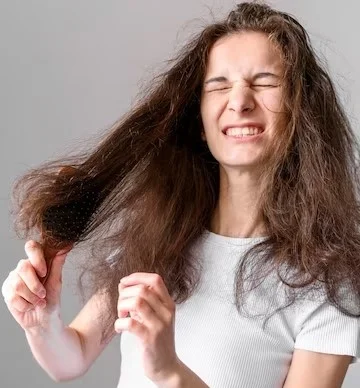Radiance Restored
Hair-loss
Explore advanced treatment options and effective solutions tailored for this condition.
Overview
Hair-loss
Losing some hair on a daily basis is a normal occurrence within your hair’s regular growth cycle. For the majority of individuals, the hair that is lost eventually regrows, allowing you to maintain a voluminous head of hair. However, factors such as illness, fluctuations in hormones, stress, the aging process, and genetic predispositions can disrupt this natural hair growth cycle. This disruption can lead to an increased amount of hair falling out, with no guarantee of new strands replacing them.
What exactly is hair loss?
An average of around 100 strands of hair is typically shed by healthy individuals each day. In the course of your hair’s growth cycle, fresh strands emerge to take the place of the ones that have been shed.
When the process of shedding hair surpasses the rate of new growth, resulting in fewer or no replacement strands, this is referred to as alopecia or hair loss. Alopecia can manifest in various forms and can affect adults of any gender, as well as children. Hair loss might occur exclusively on the scalp or extend to the body as well.
Book a personalized consultation today to discover how we can help you achieve radiant, flawless skin.

Talk to Our Experts
Hair-loss
Losing some hair on a daily basis is a normal occurrence within your hair’s regular growth cycle. For the majority of individuals, the hair that is lost eventually regrows, allowing you to maintain a voluminous head of hair. However, factors such as illness, fluctuations in hormones, stress, the aging process, and genetic predispositions can disrupt this natural hair growth cycle. This disruption can lead to an increased amount of hair falling out, with no guarantee of new strands replacing them.
What exactly is hair loss?
An average of around 100 strands of hair is typically shed by healthy individuals each day. In the course of your hair’s growth cycle, fresh strands emerge to take the place of the ones that have been shed.
When the process of shedding hair surpasses the rate of new growth, resulting in fewer or no replacement strands, this is referred to as alopecia or hair loss. Alopecia can manifest in various forms and can affect adults of any gender, as well as children. Hair loss might occur exclusively on the scalp or extend to the body as well.
What is Hair Loss?
Hair loss, known as alopecia, can be either partial or complete and may result from various external or internal factors. Typically, we naturally shed approximately 100 hairs a day. However, if you experience a more significant loss (around 120-150 hairs or more daily), or notice specific areas of your scalp thinning, it is crucial to seek advice from a trichologist without delay.
Hair loss can impact any part of the body, including the scalp. The most common form of hair loss is androgenetic alopecia, also known as patterned hair loss, which typically progresses gradually over time. Hair loss can affect individuals of all ages, with androgenetic alopecia even manifesting as early as in one’s twenties or thirties. Looking for an effective hair loss treatment? Book an appointment with thezenithasthetics (Best Dermatologist in Kharagpur) at affordable rates.
What are the various types of hair loss?
Hair loss can manifest in both enduring and fleeting ways. The principal categories of hair loss encompass:
Androgenic alopecia: This form of hereditary hair loss is prevalent in both men and women, with male pattern baldness being common among men. Women can also experience hair thinning in this pattern.
Alopecia areata: This autoimmune condition leads to hair loss on the scalp and the body.
Telogen effluvium: This type of hair loss involves the rapid shedding of hair within a brief period. It typically occurs a few months following physical or emotional stressors, as well as sudden hormonal shifts.
Anagen effluvium: A swift loss of hair, often caused by specific medical treatments like chemotherapy.
What causes hair loss?
- Genetics: Hereditary hair loss, also known as male or female pattern baldness.
- Hormonal Changes: Due to pregnancy, menopause, thyroid disorders, or PCOS.
- Stress: Physical or emotional stress can cause sudden hair shedding.
- Nutritional Deficiencies: Lack of essential nutrients like iron, protein, zinc, and vitamins.
- Medical Conditions: Includes alopecia areata, scalp infections, and autoimmune diseases.
- Medications: Hair loss can be a side effect of drugs for cancer, depression, and heart issues.
- Hair Styling Habits: Excessive use of heat, dyes, and tight hairstyles can damage hair.
- Aging: Natural aging slows down hair growth, causing gradual thinning.
What are the symptoms of hair loss?
Gradual Thinning on the Scalp: The most common type, often starting with a widening part or receding hairline.
Sudden Hair Shedding: Noticeable clumps of hair falling out while combing, washing, or on the pillow.
Bald Spots or Patches: Circular or patchy bald spots on the scalp, beard, or eyebrows.
Widening Part Line: A parting that becomes noticeably wider over time, especially in women.
Itchy or Irritated Scalp: In some cases, scalp conditions like infections or dandruff may accompany hair loss.
